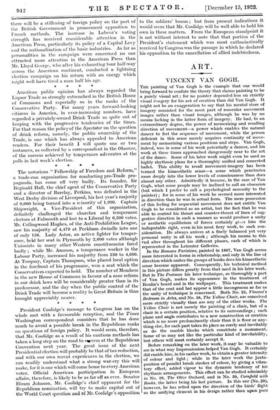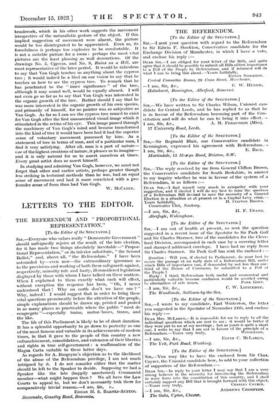ART.
VINCENT VAN GOGH.
Tin; painting of Van Gogh is the example that one would bring forward to confute the theory that claims painting to be a purely visual art ; for no painter depended less on strictly visual imagery for his act of creation than did Van Gogh. It might not be an exaggeration to say that his mental store of imagery consisted for the most part of muscular movement images rather than visual images, although he was by no means lacking in the latter form of imagery. He had, to an extraordinary degree, the power of memorizing and recalling direction of movement—a power which enables the natural dancer to feel the sequence of movement, while the person deficient in this sense merely acquires continuity of move- ment by memorizing various positions and steps. Van Gogh, indeed, was in some of his work potentially a dancer, and his work at these times approached dangerously near to the art of the dance. Some of his later work might even be used as highly rhythmic plans for a thoroughly unified and concerted ballet. This ability to recall movement-imagery has been termed the kinaesthetic sense—a sense which penetrates more deeply into the lower levels of consciousness than does almost any other. Admittedly it became, in the case of Van Gogh, what some people may be inclined to call an obsession (but which I prefer to call a psychological necessity to the painter) ; for in some of his work he seemed more interested in direction than he was in actual form. The mere possession of this feeling for sequential movement does not entitle Van Gogh to be considered as an artist, but the fact that he was able to control his thrust and counter-thrust of lines of sug- gestive direction in such a manner as would produce a unity or aesthetic equilibrium of forces certainly gi. es him the indisputable right, even in his most fiery work, to such con- sideration. He always arrives at a finely balanced yet very personal unity in all his work ; although his means to this end alter throughout his different phases, each of which is represented in the Leicester Galleries.
In the Romans Parisiens, painted in 1887, Van Gogh seems more interested in forms in relationship, and only in the line of direction which unites the groups of books does his kinaesthetic sense become apparent. Consequently, his technical method in this picture differs greatly from that used in his later work. But in The Postman his later technique, so thoroughly a part of Van Gogh, makes its appearance in the treatment of Roulin's beard and in the wallpaper. This treatment makes that of the coat and hat appear a little incongruous so far as the unity of technique is concerned. Both No. 25, Vincent's Bedroom in Arles, and No. 28, The Yellow Chair, are conceived more strictly visually than are any of the other works. The Yellow Chair is not merely the painting of a chair, but of a chair in a certain position, relative to its surroundings ; each plane and angle contributes to a new construction or creation which is no more predominantly chair than it is floor or any- thing else, for each part takes its place as surely and inevitably as do the marble blocks which constitute a monument. Some of us may not like the particular kind of inevitability, but others will most certainly accept it.
Before remarking on the later work, it may be valuable to see in what way Impressionism helped Van Gogh. It certainly did enable him, in his earlier work, to obtain a greater intensity of colour and light ; while in the later work the juxta- position of parallel brush strokes of colour, by giving a vibra- tory effect, added vigour to the dynamic tendency of his rhythmic arrangements. This effect can be studied admirably in No. 38, The Olive Orchard, and in No. 39, Cornfield with Rooks, the latter being his last picture. In this one (No. 89), however, he has relied upon the direction of-the birds' flight as the unifying element in his design rather than upon pure brushwork, which in his other work suggests the movement irrespective of the naturalistic gesture of the object. If this implied suggestion of movement were absent, the picture would be too disintegrated to be appreciated. Even so, its forcefulness is perhaps too explosive to be comfortable. It is not a suitable picture for a room : perhaps the most vital pictures are the least pleasing as wall decorations. Of the drawings No. 5, Cypress, and No. 9, Ruins on a Hill, are most representative of the later period. It would be ridiculous to say that Van Gogh teaches us anything about the cypress tree ; it would indeed be a libel on our vision to say that he teaches us how to see the cypress tree. To remark that he has penetrated to the " inner significance " of the tree, although it may sound well, would be equally absurd. I will not even go so far as to say that Van Gogh was interested in the organic growth of the tree. Rather should I say that he was more interested in the organic growth of his own species, and primarily of himself, for no painter was so subjective as Van Gogh. As far as I can sec the cypress tree ceased to exist for Van Gogh after the first unassociated visual image which it stimulated in the retina of his eye. This image passed through the machinery of Van Gogh's mind and became transformed into the kind of tree it would have been had it had the superior sense of voluntary movement possessed by him. As a statement of tree in terms of man, and of a particular man, I find it very satisfying. After all, man is a part of nature— one of the highest creations of nature, it pleases us to imagine— and it is only natural for us to assert ourselves at times. Every great artist does so assert himself.
In studying and admiring Van Gogh, however, we must not forget that other and earlier artists, perhaps greater though less striking in technical methods than he was, had an equal sense of movement and had it more correlated with a pro- founder sense of form than had Van Gogh.
W. MCCANCE.



















































 Previous page
Previous page